Scavenger Hunt
This Saturday was spent trolling around Lower Manhattan on a digital scavenger hunt. My photos can be found on my Flickr site:
http://www.flickr.com/photos/howardyeh/sets/72057594135128539/
This blog shares some of my thoughts and experiences with the Morris Academy Mentor Program. Morris Academy for Collaborative Studies is a public high school in the South Bronx. The purpose of the Program is to forge strong one-on-one relationships and bonds of trust between students at Morris Academy and caring adults willing to guide, counsel and commit themselves to those students. For further details, please visit www.morrisacademymentors.org.
This Saturday was spent trolling around Lower Manhattan on a digital scavenger hunt. My photos can be found on my Flickr site:
There was a brilliant article in April 30, 2006's New York Times about the rich musical history emanating from the Morrisania neighborhood in days gone by. The title of the article is "Morrisania Melody" by NYT reporter Manny Fernandez. He talks about jazz greats Dizzy Gillespie ("Diz") and Thelonius Monk frequenting jazz bars and dance clubs that were located just blocks away from Morris High School. There is an effort today from Mark Naison, a professor of African American studies and history at Fordham University to chronicle this rich musical time period from the 1940's to the 1960's. Morris High School itself is mentioned twice in the article as the home of the doo-wop group "The Crickets" who are known for their song, "Your Mine" and for recording with Buddy Holly. In the end of the article, the writer leads into the current hip-hop age by writing about the meeting location of one Joseph Saddler, better known as Grandmaster Flash, and Kris Parker, better known as KRS-One.
The topic of discussion today was "Making Tough Decisions". While the theme was obstensibly ambiguous, the conversations that the mentors leds with the students had to do primarily to peer pressure and the use of violence to solve disputes. There were a few incidents at the school that precipitated the discussions, not to mention the fact that students are required to go through metal detectors to walk onto the campus everyday. For this discussion, we divided up the group between boys and girls. While understanding that in a PC-era separating along gender lines is generally frowned upon, the thought here is that the pressures facing boys and girls, particularly in the high school age range are vastly different. Since I cannot speak for the discussions happening in the girls' room, I'll describe generally some of what we spoke about in our session. What causes boys to "start up" with other, in particular, are they doing it for them or for the perception of them. I think a lot of fights are started because of a perceived obligation to act. The biggest fear that runs through a lot of our students' minds is that it's more important not to be a "nobody" than to stay out of trouble. That itself is a troubling thought. It's probably more the result of want to forge an identity at an age when you are still trying to figure out for yourself who you are than any malicious intent. There's a lot more to cover on this, but I'll leave it for a separate time given the late hour of this posting. I'll promise to edit this post later on.
I'm just the messenger here, but today was a spectular win by Morris Robotics that I was honored to attend. I wanted to share with you, and anyone you wished to share with, some of the moments captured by my camera today.
The theme of today's session with Morris Academy was on etiquette and manners. This is a seemingly mundane topic, but mastery is generally the product of knowing one's environment. Greg and I led a session on etiquette and manners in a professional setting. Greg works at major ad agency on the creative side, while I work in the finance field. Call it Madison Avenue meets Wall Street. While both of us work in an office setting, it is clear that the presentation of oneself would differ between the two. The one point we wanted to get through to the students was to "know your audience". In getting a job, the goal for the applicant is to give him/herself every opportunity to get noticed. Reiterate that an interview is your opportunity to sell yourself.
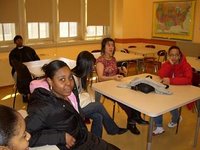
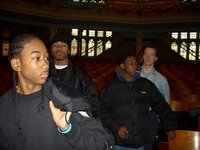
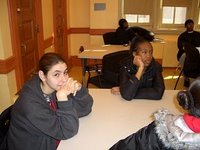
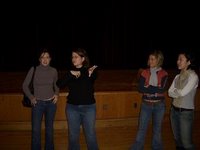
After going through my online picture album, I'm realizing that the mentoring team, both mentors and students alike, represent a wide and nutty assortment of characters. The following photo-montage is meant to be a random sampling of it. I hope that you enjoy the lighter side of Morris Academy Mentors.

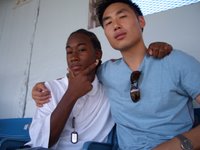



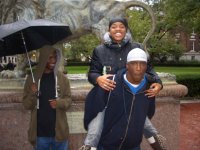
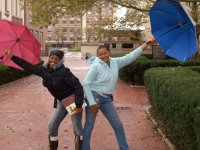







 The theme of yesterday's mentoring event was personal financial in a program titled "Control Your Money or It Will Control You". The focus was on financial responsibility and developing money management skills. The goal of the program was to help our students understand the difference between needs and wants, and to explain the basics of checking accounts, the dangers of credit cards and the benefits of saving.
The theme of yesterday's mentoring event was personal financial in a program titled "Control Your Money or It Will Control You". The focus was on financial responsibility and developing money management skills. The goal of the program was to help our students understand the difference between needs and wants, and to explain the basics of checking accounts, the dangers of credit cards and the benefits of saving.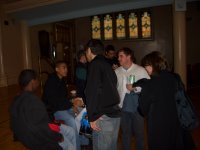

Yesterday, Mayor Bloomberg, along with Chancellor Klein, issued a press release announcing an expansion of the small school program next fall.
I traveled up to Morris Academy this past Saturday to spend some time with the students as they were attending an extra prep/tutoring session in advance of the New York State Regents exams during the latter part of this coming week. First of all, it was a wonderful sight when I first walked into the school - one of our mentors, Ji Son, spending one-on-one time with a student in our program. Our jobs as mentors are not necessarily as academic tutors, but it is a role that we can assume in certain circumstances - preparing for the Regents being one of those. I think what's more important than the instruction is the level of focus that one-on-one attention can provide for the students.
New York Times Education reporter Michael Winerip published an article appearing in the November 16 issue of the New York Times describing the efforts of Admission Possible, nonprofit program based in Minneapolis that provides SAT/ACT prep and college admissions resources to lower income students the in Minneapolis/St. Paul region.
Greetings readers! I unfortunately was not able to attend the most recent Morris Academy Mentoring event held on November 5, 2005. The description of the agenda for this Saturday's event (in quotes below as written by Brett Anderson) suggested that this would be one of the most relevant events to date, as it deals simulateneously with college planning, job-preparation, writing, and presentation skills.
We had today, in my opinion, one of our more memorable and rewarding mentoring events since the inception of the mentoring program in September 2004.
 From a functional standpoint, hearing his college planning process firsthand was hopefully a beneficial educational experience for the students. Daniel is an ideal role-model for these kids, having come up from similar beginnings and maintaining day-to-day contact with them. He told them that there were scholarship opportunities out there for them. He encouraged them to start thinking early about SATs, and taking it multiple times (he himself took it three times, and improved his score each time). He also recounted to them his college experience attending and graduating from Brown University. While an accomplishment in and of itself, it was not without its difficulties.
From a functional standpoint, hearing his college planning process firsthand was hopefully a beneficial educational experience for the students. Daniel is an ideal role-model for these kids, having come up from similar beginnings and maintaining day-to-day contact with them. He told them that there were scholarship opportunities out there for them. He encouraged them to start thinking early about SATs, and taking it multiple times (he himself took it three times, and improved his score each time). He also recounted to them his college experience attending and graduating from Brown University. While an accomplishment in and of itself, it was not without its difficulties.

He pressed upon the students to expect a culture gap that exists for students matriculating into an institution like Brown. Daniel talked about the hardships endured in adjusting to an academic and cultural environment far different than that of his upbringing in the South Bronx. However, he urged them to fight through it, saying that (1) getting the acceptance letter from Brown was “one of the two happiest moments of my life, the other being witnessing the birth of my son” and (2) despite the numerous hardships of feeling like an outsider at Brown, he would never trade away his experience there.
From an academic standpoint, Daniel relayed that the most frustrating part experience at Brown was not knowing that what he was doing wrong was in fact wrong. I could relate to that point completely: It’s one thing when you understand the mistake you are making, and aim to fix it in future occurrences. It’s another when you can’t recognize where you’re at fault. He explained to the students that they were likely to go through similar experiences in the future, but encouraged them to continue working through it.
He told us that all of this changed once he rededicated himself to excel academically, and when he started to realize his ambition for teaching. The coursework then became more focused and relevant, and he could start to see the forest from the tree (my words, not his).
During his speech, he stressed the importance of writing, and put it in even starker terms for the students. As a result of one essay for a Taft High School scholarship, Daniel received $9k to cover tuition expenses over his four years at Brown. In other words, One Essay = $36k. He also submitted pieces of poetry to the NAACP as part of a separate scholarship program, and received additional financial support. All in, he was able to reduce what would have normally amounted to $35k of annual tuition plus living expenses at Brown to a few thousand dollars annually as a result of these scholarships.
Out of the Q&A, one characterization that was striking to me came as a result of a question I posed to him. I had asked him how his relationships with friends from high school changed as it became clear that he was headed to college. It was an issue for Curtis Jennings in “A Hope for the Unseen”, a non-fiction account of a student in a very similar circumstance written by former Wall Street Journal report Ron Suskind. Daniel’s response was somewhat surprising, considering the struggles he underwent to reach his academic achievements. He told us that his high school accomplishments were not extraordinary in the sense that it could have easily been one of his friends that made it to college and not him. He told us that not every one of his friends had an opportunity to attend SAT prep offered as part of a special program at Clinton High School. My take is that it was a mix of humility, given that he did graduate as salutorian (second-ranked student in graduating class) at Taft, and realism about his situation. For those qualities, I admire him even more.
The takeaway for the students: Don’t let your struggles define you. Instead, what matters more is how you approach those predicaments, and how you come out as a person.
Goal-Setting Exercise
The second half of the program was set on the practical exercise of goal-setting. We had originally done a session with the students during the 2004-2005 academic year, in which the students were asked to enumerate their goals in the context of short-term personal and academic, and long-term personal and academic goals. These goals were characterized based on the following:
SMART Goals
S=Specific
M=Measurable
A=Attainable
R=Realistic
T=Time-Sensitive

Recap of Breakout Session 
Columbus, Jon, Brian, Glenn and I spent time together in a back conference room with the purpose of doing a goal-setting exercise. However, the natural progression of our conversation started with a question regarding Columbus’ and Jon’s college ambitions. We learned that both of them were intent on going, and as sophomores, they are gearing the remainder of their high school years with that goal in mind. We talked about the SATs, and their readiness to begin studying for the exams. We also talked about the job-search process, in particular, hearing their frustrations in trying to find part-time jobs. We encouraged them to be more proactive in call-backs and initiating meetings with hiring decision-makers. Lastly, we tried to get from them some perspective on what we’re hoping to do with the Morris Academy Internship Program, which I’ll discuss in a separate posting once we fill out the details.
Columbus then asked us whether we believed the military would be a viable option for them. My response was that I had seen friends of mine go through basic training and enlisted service, and they generally came out with a higher level of discipline, responsibility, respect for systems, and work ethic. Glenn had the most to say about it because he has a sister who is an Air Force reservist on the medical side. Columbus mentioned that he had in fact met with recruiting officers to get first-hand accounts for military life. We encouraged him to continue to do so, but to also keep non-military options open as well.
Next, we asked both Columbus and Jon to give honest answers about what they were looking to get out of the mentor program. They offered these reasons (in no particular order): (1) spending time with friends, (2) understanding an adult perspective for jobs, broader responsibilities, etc., and (3) support from mentors. We then returned the favor by giving our reasons for wanting to become mentors – gravitating outside our usual social bubble, giving back in a way that acknowledges how fortunate we are to be where we are, believing that the mentor/mentee relationship is a reciprocal learning experience, and wanting to contribute to our communities in a meaningful way.

Unfortunately, with all of this discussion, we only got to peel away the first layer of the goal-setting exercise before the 11:45am mark hit and the scent of pizza finally made its way to the back of the office. Despite not achieving the nominal goal of setting goals (I know, the irony is striking), I think Glenn, Brian and I all learned something and gained a larger perspective for the mentor program in general.
For those interested in getting a visual look at the event, please find the online photo album at the follow flickr link:
http://www.flickr.com/photos/75191100@N00/sets/1191062/
Tour of Columbia University 
The final leg of the day was a physical tour of the Columbia University campus uptown. Due to some brilliant planning coordinated by our programming team and the team of Sheba Sethi/Ejike Uzoigme, the group was able to turn the discussion of college planning into concrete ways by showing the students life on an elite college campus. Ejike showed the poise of a true admissions officer as he took a group of 25 or so students and mentors around campus. He imparted knowledge of the university unseen from even current students there (slight exaggeration, but not too far away from the truth). It was factoid after factoid of hidden truths. It was also impressive the level of access we got from the campus considering that we were not a sanctioned tour. We were granted entry into all of the floors of the student center, the auditorium, and the library. Due to the rowdiness of the group, I had at times difficulty telling who was better behaved, the high-schoolers or the mentors. Nonetheless, it was quite an educational experience for the students, and an entertaining time for the mentors.
 The highlight of the tour of Columbia came when a family from Cleveland, OH, who was making a college visit along with their son, a high school junior, joined us on the tour. At first, we didn’t have the heart to tell them that the impromptu tour was not an officially sanctioned one from the admissions department. However, it soon became clear that they, along with all of the students from Morris, were in very-good hands with our resident mentor/Columbia alumnus (for those viewing the photos of the event, Ejike is the black guy wearing the red/black North Face jacket). Once we explained what we were doing, and after they lamented the fact that there were no scheduled tours during the day, we asked them to continue to tag-along. A few of the mentors, myself included, even initiated conversation with the son to impart whatever knowledge we could about the college process. I think they were appreciative of it, and hope that we gave them a favorable view of our city.
The highlight of the tour of Columbia came when a family from Cleveland, OH, who was making a college visit along with their son, a high school junior, joined us on the tour. At first, we didn’t have the heart to tell them that the impromptu tour was not an officially sanctioned one from the admissions department. However, it soon became clear that they, along with all of the students from Morris, were in very-good hands with our resident mentor/Columbia alumnus (for those viewing the photos of the event, Ejike is the black guy wearing the red/black North Face jacket). Once we explained what we were doing, and after they lamented the fact that there were no scheduled tours during the day, we asked them to continue to tag-along. A few of the mentors, myself included, even initiated conversation with the son to impart whatever knowledge we could about the college process. I think they were appreciative of it, and hope that we gave them a favorable view of our city.
 Here is the flickr link for the Columbia tour:
Here is the flickr link for the Columbia tour:
http://www.flickr.com/photos/75191100@N00/sets/1191149/
As an update to those involved with the program, we held an organizational meeting for the mentor program last night. It was well-attended by mentors, one of the teachers at the school (Sunny) and by Charles Osewalt. We made some good progress, and so here is a summary of the discussion:
1. Update on Recruiting
2. Update on Programming
3. Update on WCBS Relationship
4. Update on Mentor Relationships
5. Update from Webmaster
6. Introduction to Morris Internship Proposal
7. Miscellaneous
Writing Skills
We need to encourage the students to write more. Many of the students’ writing skills are below average. While we are not expected necessarily to serve as tutors, it is within our charter to encourage them to write. Suggestions include public discussion groups on the website, an essay contest and creative writing projects. We should be encouraging them, as this will be a gating item for them in both employment and college applications. Some creative ways to implement include, at Charlie’s suggestion, using financial incentives (grant money to the school) to encourage students to write. Lindsy Carpenter, who has had prior experience in such a capacity, volunteered to lead a writing workshop with the Morris students.
New York Times Article
Charlie announced that he expects the New York Times education column in next Tuesday’s (10/25) edition will have a brief mention of Morris Academy and the mentor program.
 Welcome to the inaugural posting of “Morris Academy Mentors – Bronx Collaborative”, a blog that shares some of my thoughts and experiences with the Morris Academy Mentor Program. Before I begin, I want to first give this disclaimer: The contents of this web site are mine personally and do not reflect any official position of the Morris Academy for Collaborative Studies or its teachers and administrators, nor does it reflect the position of the New York City Board of Education. I’m not an attorney, so the point of this is not a legal one. The reason I want to stipulate this point up front is because there are a number of hard-working, dedicated individuals and organizations that make the Morris Academy Mentor Program a reality. I would hate to ever unintentionally misconstrue any of those efforts in this blog in a way that would be detrimental to what they are doing and will be doing. So with that caveat, onward…
Welcome to the inaugural posting of “Morris Academy Mentors – Bronx Collaborative”, a blog that shares some of my thoughts and experiences with the Morris Academy Mentor Program. Before I begin, I want to first give this disclaimer: The contents of this web site are mine personally and do not reflect any official position of the Morris Academy for Collaborative Studies or its teachers and administrators, nor does it reflect the position of the New York City Board of Education. I’m not an attorney, so the point of this is not a legal one. The reason I want to stipulate this point up front is because there are a number of hard-working, dedicated individuals and organizations that make the Morris Academy Mentor Program a reality. I would hate to ever unintentionally misconstrue any of those efforts in this blog in a way that would be detrimental to what they are doing and will be doing. So with that caveat, onward…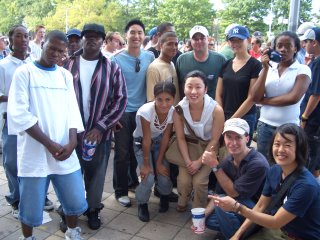
The reasons for becoming a mentor vary among the mentors themselves. For some, their personal beliefs compel them to serve others. For others, myself included, it was a desire to feel part of an integrated community that one felt some vested interest in progressing forward. Some mentors feel an innate connection with those younger than them, and want to use that gift for the benefit of others. Some mentors just want to do something productive and structured with their Saturday mornings. Some volunteer on the basis of the relationships they have with other mentors going into the program, and therefore they find value in the shared experience of volunteering their time. Some do it in part because they genuinely believe it is time well spent. And underlying all of this is a bond among mentors and between the mentor and his or her mentee. They do it for the same reason that friends help friends, they just do.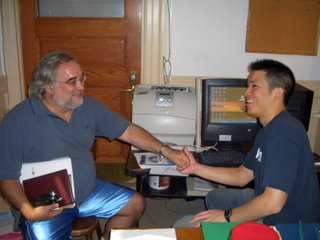 The other reason for doing this is the inspiration provided by Charles Osewalt, school director at Morris Academy and a truly dedicated, life-long educator. He possesses a view that brings learning outside of the classroom and makes it a collective calling of the community, including parents, teachers and seemingly disinterested constituents. He tries to involve as many people in the education of his students as need be, and in the New York City public school system, that need is aplenty. His dedication to his cause is truly inspiring. How many principals in life have you come across that knows the personal story of each of his students? As a general rule, I tried to avoid my high school principal, as there was typically little upside and a whole lot of downside. Charlie’s role as school director at Morris Academy could not be anything further from this view.
The other reason for doing this is the inspiration provided by Charles Osewalt, school director at Morris Academy and a truly dedicated, life-long educator. He possesses a view that brings learning outside of the classroom and makes it a collective calling of the community, including parents, teachers and seemingly disinterested constituents. He tries to involve as many people in the education of his students as need be, and in the New York City public school system, that need is aplenty. His dedication to his cause is truly inspiring. How many principals in life have you come across that knows the personal story of each of his students? As a general rule, I tried to avoid my high school principal, as there was typically little upside and a whole lot of downside. Charlie’s role as school director at Morris Academy could not be anything further from this view.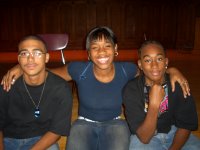 The fact is that many of these students need that kind of attention. Some are from single-family households and some are from households in which they are one of many children who have responsibility in not only raising themselves but also their siblings. Despite his best efforts, Charlie is only one person. It’s often said that “it takes a village” to raise the next generation. My only complaint with that statement is that it is oftentimes used in too high a level by politicians and social commentators lacking an overt desire to put their thoughts into action. However, the underlying premise is true. Charlie’s vision of a “collaborative community” partners teachers with administrators with parents with community groups with non-governmental organizations (NGOs) with private enterprises and so on and so forth. That is where the Morris Academy Mentor Program comes into play. As a community-based mentor group, we seek to offer a perspective and resource to the students that they would not normally have in the school environment. We are adult figures that hope to serve as positive influences for and counselors to the students. We are peers in which they can feel comfortable in interacting. We are sometimes conduits to their parents who may sometimes feel a generational gap with their children. We are their friends and they are ours. In the end, I hope that our program can add something to the lives of our students in a way that is real and lasting.
The fact is that many of these students need that kind of attention. Some are from single-family households and some are from households in which they are one of many children who have responsibility in not only raising themselves but also their siblings. Despite his best efforts, Charlie is only one person. It’s often said that “it takes a village” to raise the next generation. My only complaint with that statement is that it is oftentimes used in too high a level by politicians and social commentators lacking an overt desire to put their thoughts into action. However, the underlying premise is true. Charlie’s vision of a “collaborative community” partners teachers with administrators with parents with community groups with non-governmental organizations (NGOs) with private enterprises and so on and so forth. That is where the Morris Academy Mentor Program comes into play. As a community-based mentor group, we seek to offer a perspective and resource to the students that they would not normally have in the school environment. We are adult figures that hope to serve as positive influences for and counselors to the students. We are peers in which they can feel comfortable in interacting. We are sometimes conduits to their parents who may sometimes feel a generational gap with their children. We are their friends and they are ours. In the end, I hope that our program can add something to the lives of our students in a way that is real and lasting. With these introductory thoughts, I’ll conclude my inaugural posting. There is so much more to say about this program, but thankfully I will have many more postings to offer those up. I’ll also on occasion post photos from some of our events so you might get a flavor of what we’re doing. If anyone reading is interested in finding out more about the program, please visit our website at http://www.morrisacademymentors.org/. If anyone reading this blog has (1) ever considered becoming a mentor and is (2) interested in learning what it means to join the Morris Academy Mentor Program, please email us at recruiting@morrisacademymentors.org.
With these introductory thoughts, I’ll conclude my inaugural posting. There is so much more to say about this program, but thankfully I will have many more postings to offer those up. I’ll also on occasion post photos from some of our events so you might get a flavor of what we’re doing. If anyone reading is interested in finding out more about the program, please visit our website at http://www.morrisacademymentors.org/. If anyone reading this blog has (1) ever considered becoming a mentor and is (2) interested in learning what it means to join the Morris Academy Mentor Program, please email us at recruiting@morrisacademymentors.org.
In the meantime, take care and have a wonderful fall weekend.
(Also, in the future, I’ll try to not sound so formal in my postings. I seem to have a bias towards formality when typing. It must be some subconscious view that printed or published words have some level of permanence. I generally don’t talk like this, so that must be it. Anyways, I’ll try.)